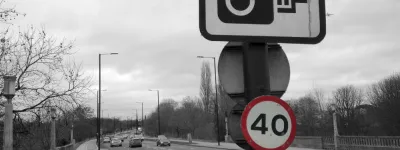It's become something of a cliché to claim that at the end of 1959, Britain was on the eve of a new era. But in transport terms, it was, and one event can be regarded as the turning point. In December 1959, the first section of the M1 opened: more than fifty miles in length, it was the second motorway the country had seen and to this day is the longest continuous length built at once.
The section of M1 between junctions 6 and 19, along with the M10 and M45 spurs, remains surprisingly intact and is recognisably the same road that was opened by Ernest Marples nearly fifty years ago. The main reason is that this section of motorway has its own unique style of architecture, an unmistakeably fifties design. The pioneering road was given a visual treatment by a pioneer in concrete architecture, Sir Owen Williams.
Today most of his sculpted flyovers are under threat: the overdue improvements to this road, which will widen it for the first time since it was opened, will end up destroying most of its unique architecture out of necessity. This page exists to try to document some of the things that make the road unique.
Alignment
Some parts of the road can be easily identified by its alignment. It is overwhelmingly straight and open, much more so than later roads. This broad expanse of tarmac, at the M45 merge, would have been the widest road in the country for several years. The surface is showing its age with a large pothole in the foreground.
A typical view of the road — the crash barriers, lighting and variable message sign are additions, but the road and bridge are 1959 vintage. More on the bridges in a moment.
Straight and open again. In order to reduce land-take it avoids cuttings and embankments, instead simply riding out every dip and rise of the land, and making extensive use of retaining walls. The streetlights break at an old emergency crossover point, long since closed.
Possibly the most famous dip, the road runs ruler straight through this valley near the A5 junction at Whipsnade.
The Luton Airport spur at junction 10 follows the pattern — it's about a mile long and hasn't a bend in all its length.
A more recent feature, but one that makes it no less identifiable, is the catenary lighting on the section immediately north of the M25.
Bridges
The most unique thing about the M1 is the style of its bridges. They are a very smart piece of design — understated but attractive, though they have the ability to look overly chunky in the wrong light. They must have looked stunning when the concrete was new and white.
Each bridge is derived from the same blueprint, simply skewing or stretching the same design to meet the needs of the individual locations in terms of length, width, depth, height and angle.
A local road passes underneath the motorway and, sure enough, the same bridge design is used down here.
From inside it's almost like being in a tunnel, with the curved roof and the length. It doesn't seem as oppressive or unnatural as a normal angular design.
Another minor road south of junction 13, and here the underpass fits right into the landscape by echoing the arch of the trees.
The bridges have four circular 'feet', a detail that is all too easily missed or buried in undergrowth.
Sloping up from the feet, the side is ridged to prevent a large, bare expanse of concrete. The bevelled edge curves to become part of the parapet.
From above, it's clear that the bridge top is made to appear as though it rests on a lower pedestal, which has the rounded ends as seen above.
Another view of the pedestal. The objective of this design seems to be to create a flyover on a human scale; it curves the bridge deck downward to prevent it looking like a flat deck resting on pillars, and textures and bends all the edges and surfaces to prevent any flat expanses of concrete.
The parapets end abruptly on the top, giving an opportunity for a cross-section view. The rail on top is a later addition, perhaps when the bridge deck grew higher with progressive resurfacing work. The wall itself looks rather insubstantial.
Along the outside, the parapet has several steps to accompany an inward lean. This view also highlights the bridges' inbuilt safety device: when the M1 was opened there were no barriers, so the central pillars are built into a traffic island which is shaped to bounce traffic back into its own carriageway.
Service areas
Approaching Watford Gap services, Britain's first motorway service area. The sign proclaims it to be "now fully open", though to the best of my knowledge it has been open since about 1960.
The building itself is completely changed, rebuilt in the 1980s to provide more modern facilities. The service area retains its unique and very basic shape — a car park alongside the motorway with a building at the back — that later service areas rejected.
The new building is forward of the original one. Right in front of it this fragment of a road marking survives from the original layout.
M4Simon worked on the widening between junctions 9 and 10, and adds the following information:
"At M1 junction 9, the Owen Williams bridge was widened by stitching on a large reinforced concrete deck which was similar in shape to the original bridge, but wasn't identical. Therefore, from the east, the bridge looks as it always did, but from the west it looks, well, not great, in my opinion. It should either have been built to look like an entirely new modern structure, or it should have replicated the original profile of the bridge. It looks bodged, in my view."
With thanks to M4Simon and A303Paul for information on this page.


























